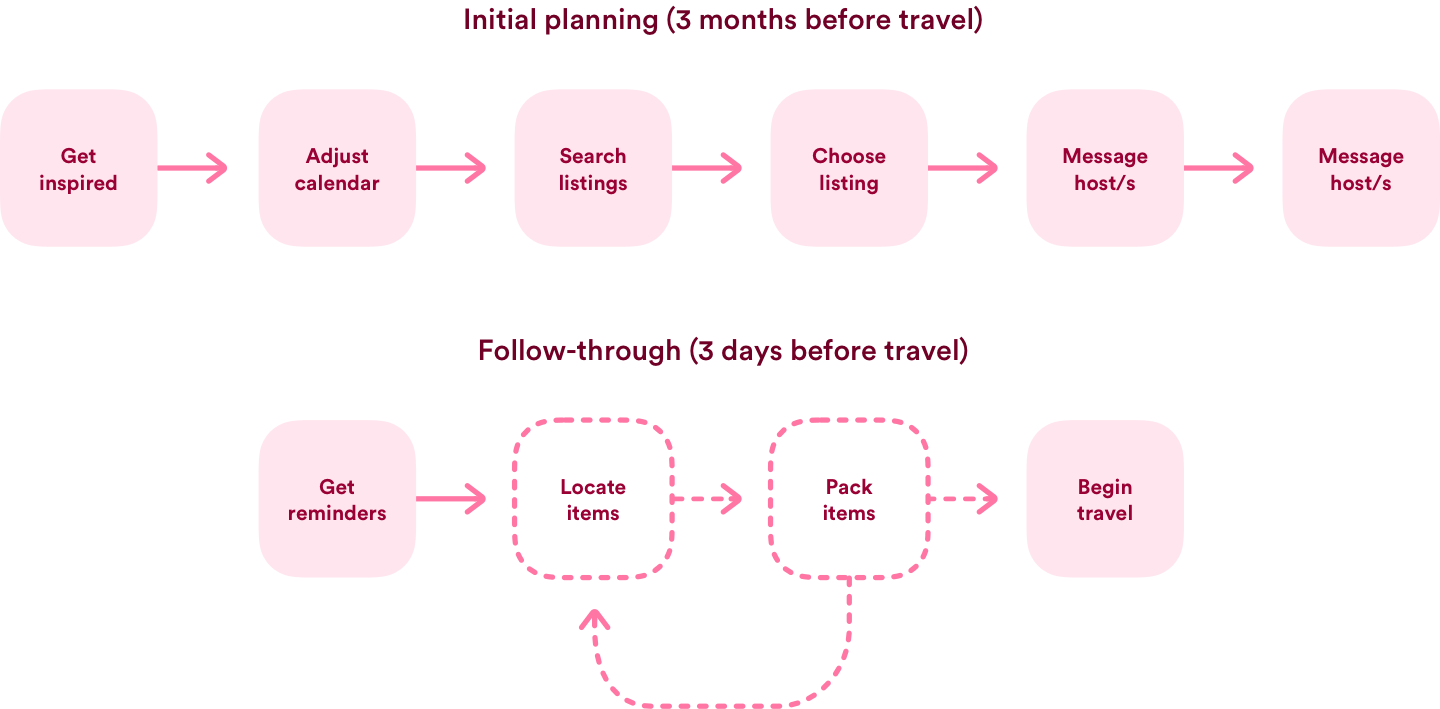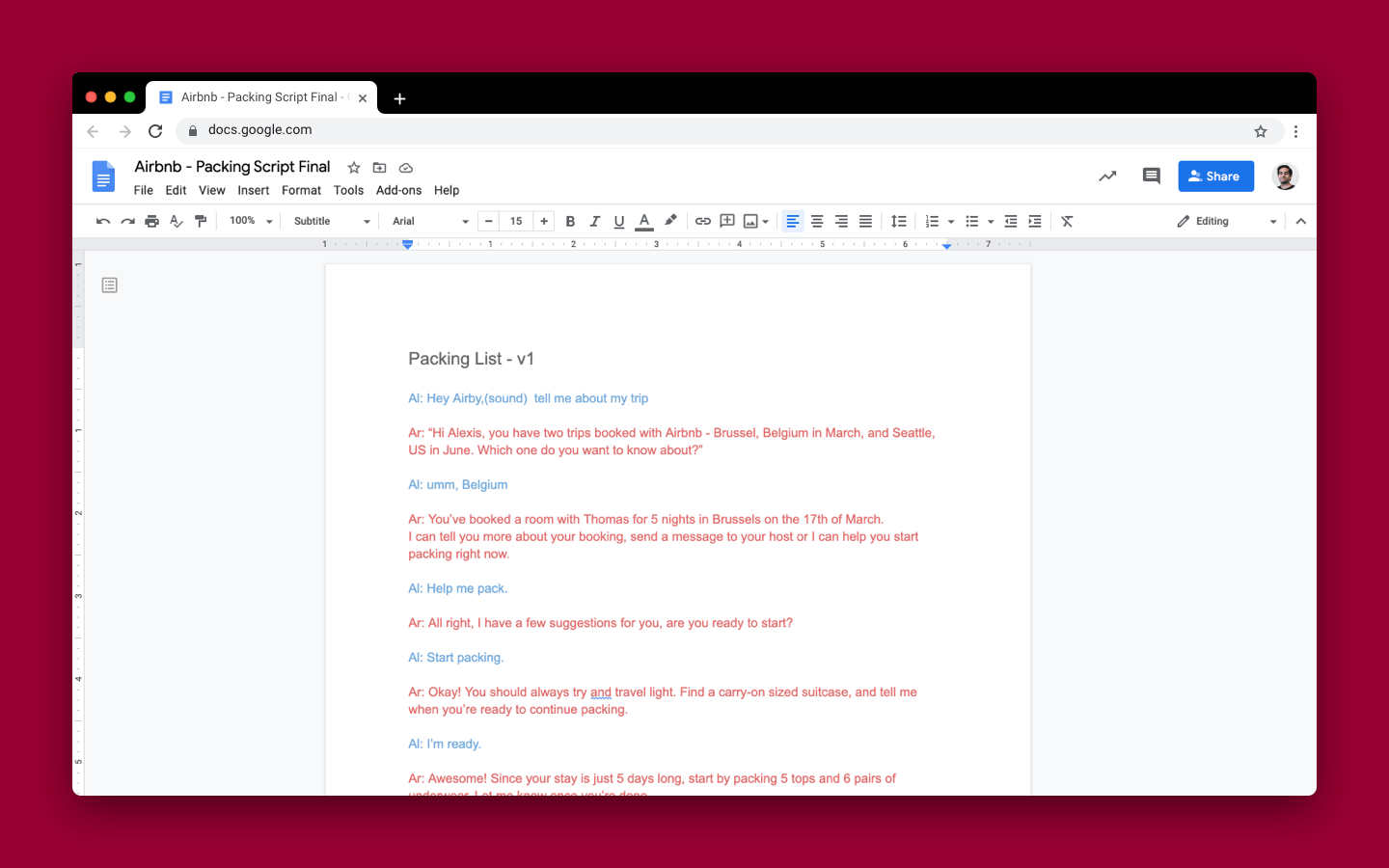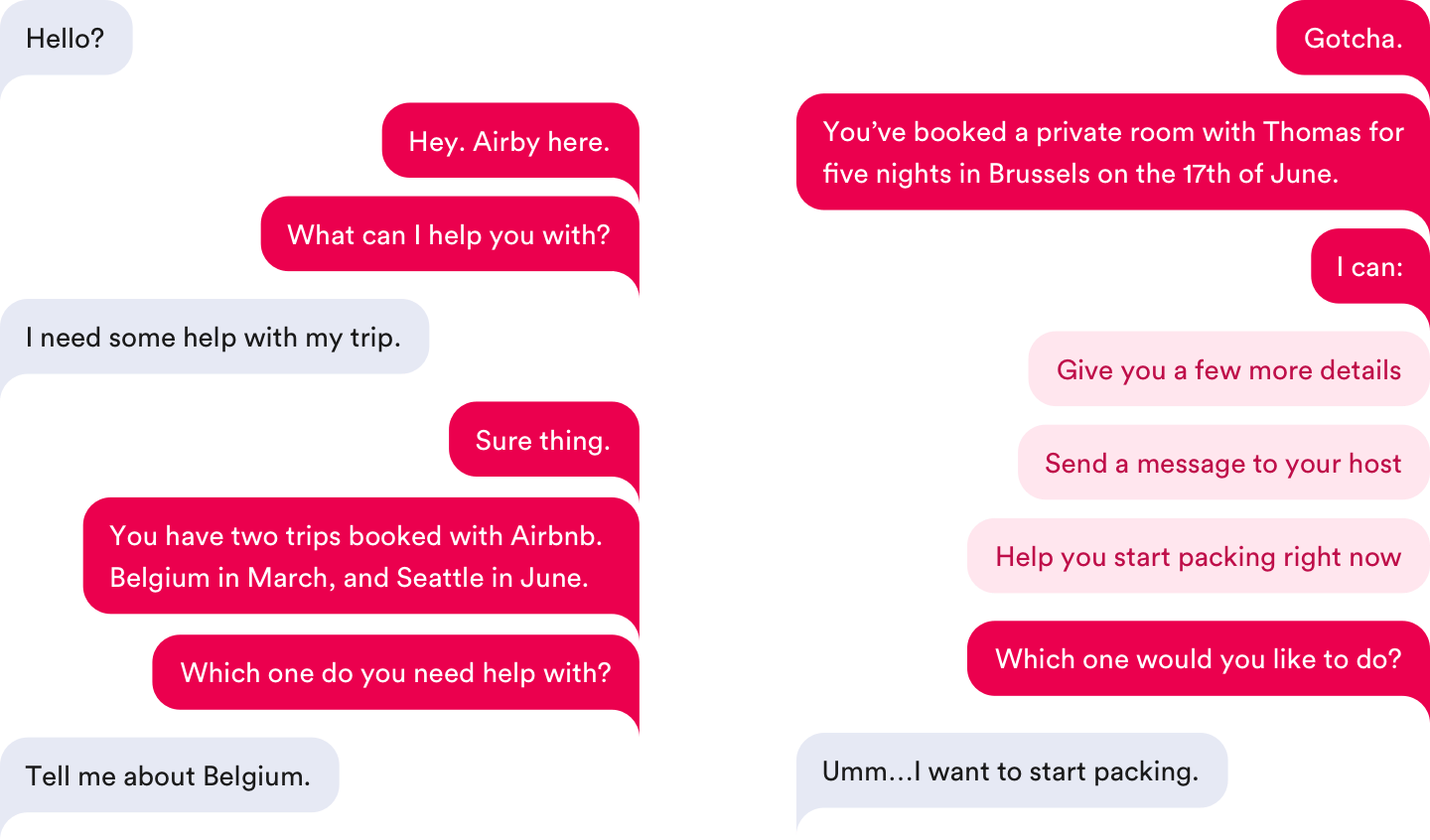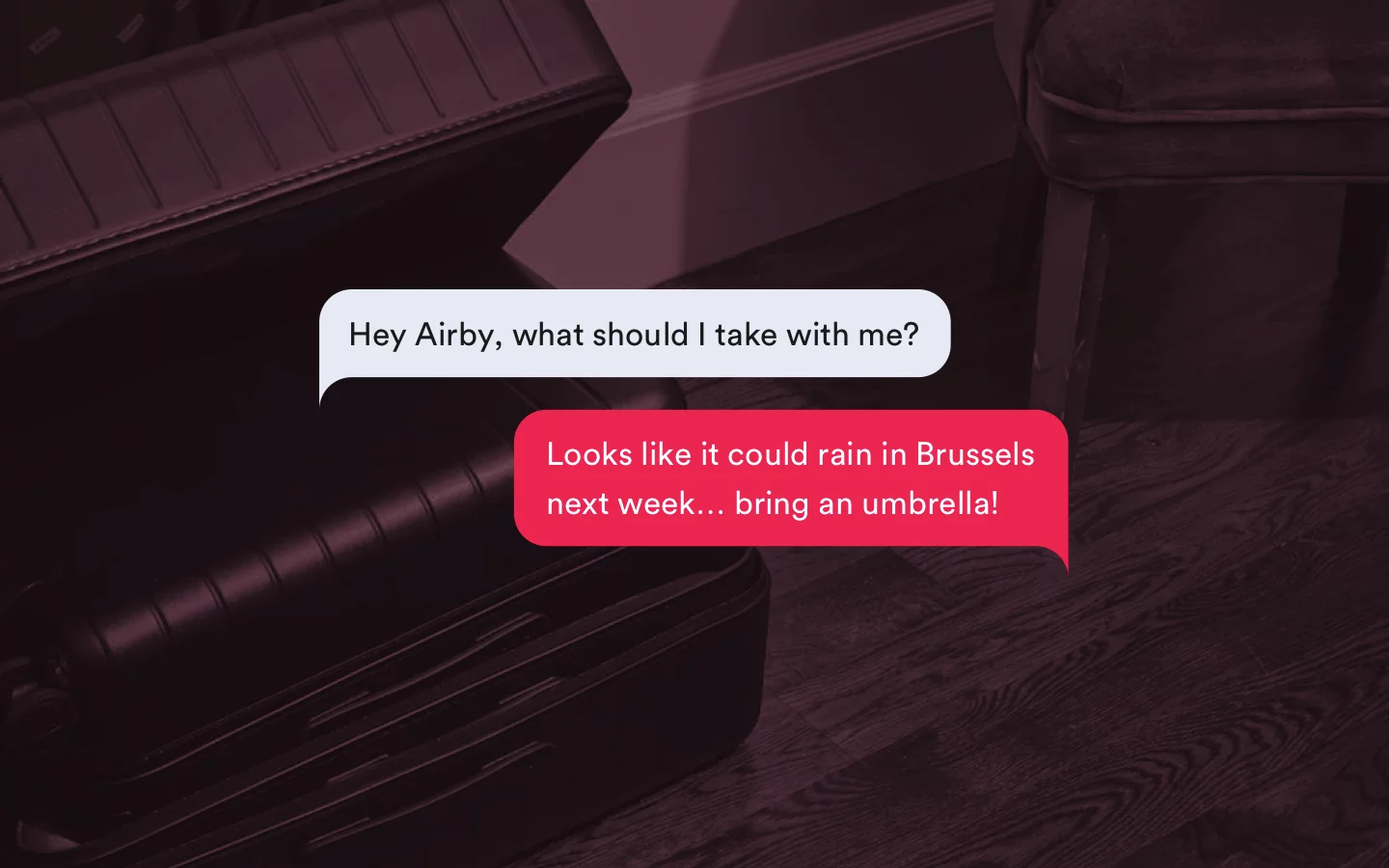Taking away the pain of travel preparation
Airby is a voice assistant and conversational interface that provides personalized, relevant information to Airbnb customers. With Airby, travelers can be prepared for trips with information on visa requirements, weather information, and suggested packing lists.
I was the lead prototyper/conversation designer for this project with Alexis Bustos and Yang Hong.
Brief
Design a meaningful, playful conversation that drives more engaged interactions with Airbnb's existing elements.
What I Did
I scripted, deployed, and tested a functional voice prototype of Airby using Dialogflow and a Google Home Mini.
Type Of Work
- Conversational Design
- Experience Design
- Voice Interface
- Prototyping
- Branding
Class
Time Studio 3: Play (2018)
Instructor
Context
Expanding beyond homes
Airbnb is a San Francisco-based company whose primary business is operating a two-sided marketplace for short-term rentals around the world. Hosts can list spare rooms in their apartments or homes available for rental, and guests can find unique local lodging tailored for their needs.
In 2016, the company launched Trips, Experiences, and Places:
For many people, travel is easy, but it's not magical. If you want to have an amazing trip, you basically end up on a research project. You might search online, get guidebooks, download an app (or 20)... Pretty soon, you could spend as much time planning your trip as you would on the trip...We don't think there should be a trade-off...travel can be magical and easy.
Brian Chesky Launches Trips | Airbnb Open 2016 | Airbnb (YouTube)
As the company expands into other parts of the travel experience, how can Airbnb drive more engaged interactions on its platform?
Discovery
Analyzing the journey
We spoke to 6 Airbnb customers from varied personal backgrounds to understand how they use the service. We used these interviews to find and map out common steps that they take, which usually happen before their travels.
A typical customer journey begins with a need for a room in a new place. Customers search for and book listings several months in advance to have enough time to arrange other aspects of their travel. A few weeks or days before their trips, customers begin to follow through on their reservations.

Observation
Frustration with preparation
For Airbnb users, the act of traveling offers a break from their usual routine. Going on these breaks may be rewarding, but planning this travel involves dealing with a lot of uncertainty, which can reduce motivation and increase stress. These negative feelings become overwhelming right before users' departures—during moments like packing.
There's always so much planning to do before I travel. Applying for a visa. Booking flight tickets. Finding a place to stay. I’ll be packing my stuff the night I’m flying out, which gets pretty stressful.

Siyun Y.
22 years old
It's hard to know everything you need to take. Once, I had to travel to Europe for work and I forgot to carry the right plug adapter with me. I couldn't charge my phone for 2 days.

Phil F.
38 years old
Functionality
Contextual travel information
An intelligent voice interface aligns the information in a system with the context of its users - helping them gain clarity and get things done. Our team mapped the data from the Airbnb platform into features that would reduce uncertainty and motivate users for their travels. These functions include suggested packing lists, weather notifications, essential reminders, and recommendations.

Branding
Friendly, curious, excited.
Unlike regular applications, voice interfaces don't always have the luxury of communicating with visuals. A voice assistant communicates brand primarily through its words and personality - like a character in a story. Our team used the values from Airbnb's existing writing guidelines to develop four principles for Airby's brand voice: helpful, inquisitive, insightful, and direct.

Design
Prototyping a script
Human conversations don't usually follow a script, but a good voice interface starts with one. Airby's language needed to be efficient and clear to move people through the packing process comfortably. We used this context to develop our conversation script.
This script would be the basis for our final demonstration of Airby's personality and features. We can categorize the interactions with Airby into two types:
- Dialogue: Extended conversations with multiple options and paths (e.g., packing list interactions)
- Queries: Simple questions or commands (e.g., asking for a weather forecast)
Our final demonstration used an overarching dialogue about the packing list with occasional queries about room amenities and weather.

Development
An invisible interface
As the lead prototyper, I was responsible for turning our team's script into a functional voice prototype. For this project, I used Dialogflow - a natural language understanding platform by Google. We could use Dialogflow to deploy a prototype of Airby on a Google Home device as a usable voice experience.

Language
Controlling responses
While visual interfaces can guide users through a linear process by disabling unnecessary actions, voice interfaces accept all spoken inputs at every stage of a process. When a system can act on any command at any stage, it makes it more likely for a user to get confused and exit the main task.
To solve this, I adjusted the wording in each response to include a leading question at the end. These questions would show users their available options at any stage in a conversation and provide them with the language necessary to trigger the next action.

Speech
Refining the voice
I deployed an initial build of Airby onto my Google Home Mini and brought it to the classroom for testing. All four people I tested the conversation flow with were able to successfully create and go through a packing list with their voice.
However, all four participants also noted that the spoken dialogue was often slow or monotonous at times - which made the voice interactions less enjoyable. To make Airby's voice sound more natural, I used SSML (Speech Synthesis Markup Language) to adjust the speed of phrases and insert natural pauses between them.
<speak>
<prosody rate="fast">Hey.</prosody>
<break time="100ms"/>
<prosody rate="default">Airby here.
<break time="200ms"/>
What can I help you with?
</prosody>
</speak>
 Listen (with SSML)
Listen (with SSML)
Hey. Airby here.
What can I help you with?
 Listen (without SSML)
Listen (without SSML)
Next steps
Growing the system
Fantastic job using a persona and naming that explicitly for your character early...it was a charming personality balanced with what is a very functional use case. Great work identifying the opportunities in becoming proactive about packing and addressing travel anxieties. This is the ideal of what voice apps can do.
- Final written feedback on the project from the instructor, Catherine Herdlick
Our team was largely successful in developing a coherent, enjoyable voice experience around packing for Airbnb users. To improve Airby even further, we could explore:
- Creating a chatbot prototype of Airby to test online
- Using APIs to fetch real-world responses for weather and traffic
- Explore other conversation flows (e.g., booking a listing or communicating with a host)

